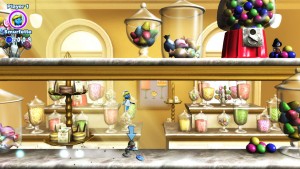 The Smurfs 2 hits today (7/31) in theaters round the country. For many of us, it might as well be playing the chorus to this on a loop for two hours. But, let’s face it, the first one made $140 million. Chances are good if we have young relatives or older relatives looking for an inoffensive night out that doesn’t involve Hugh Jackman stabbing things in the jugular, this will find its way in front of some of our eyeballs. And especially with the younguns, there’s also chance the game, published by UbiSoft, for 360, PS3, Wii, WiiU, and DS, will follow suit.
The Smurfs 2 hits today (7/31) in theaters round the country. For many of us, it might as well be playing the chorus to this on a loop for two hours. But, let’s face it, the first one made $140 million. Chances are good if we have young relatives or older relatives looking for an inoffensive night out that doesn’t involve Hugh Jackman stabbing things in the jugular, this will find its way in front of some of our eyeballs. And especially with the younguns, there’s also chance the game, published by UbiSoft, for 360, PS3, Wii, WiiU, and DS, will follow suit.
At least this time round, just like the live-action movie, the initial reaction is “Wait, _____ was involved in this?!” In this case, instead of Neil Patrick Harris, et al filling in that blank, it’s Wayforward Technologies, who have Contra 4, Double Dragon Neon, Batman: Brave and the Bold, Duck Amuck, Silent Hill: Book of Memories, Adventure Time: Hey Ice King Why’d You Steal Our Garbage, and the upcoming Ducktales Remastered under their belts. Surprisingly enough, or unsurprisingly, considering the CV above, The Smurfs 2 follows suit in being a licensed title that ISN’T terrible. It’s actually kind of a lush, simplistic, guilt-free throwback to platformers of old. But I actually have a review forthcoming that’ll go into that.
Regardless, if we are going to be faced with a Smurftastic weekend, whether we want it or not, we might as well stare back into the abyss a bit and focus on the positives. And in the game’s case, the video game being better than the average cash grab presented an opportunity, as part of the film’s release to pick the brain of one Adrian Price, producer over at UbiSoft, about the ins and outs of making a summer-blockbuster licensed title, especially one with a damn decent developer at the helm.
Justin Clark: First things first, can you tell us a bit about your experience in the industry, how long you’ve been in, what other games have you worked on?
 Adrian Price: I’ve been in the industry about 20-odd years now. I started out as a journalist, like yourself, in the UK. left that to work for Future Publishing for a few years. Worked in PR, marketing. I’ve spent the last 15 years doing production for a variety of companies. Lego, Lionhead, Lucasarts, working on stuff like Fable, Lair, a variety of social games, and now I’m a producer at UbiSoft.
Adrian Price: I’ve been in the industry about 20-odd years now. I started out as a journalist, like yourself, in the UK. left that to work for Future Publishing for a few years. Worked in PR, marketing. I’ve spent the last 15 years doing production for a variety of companies. Lego, Lionhead, Lucasarts, working on stuff like Fable, Lair, a variety of social games, and now I’m a producer at UbiSoft.
Justin: In terms doing licensed games, is it a matter of the project choosing you or you choosing the project? Are you hired on, or do you get to say “I want to make a game out of this property”?
Adrian: Most of the time, the companies I’ve worked for, they’re already in development, so I get assigned to those, or licensing departments are such where they’ll pick up deals, and they’ll see who’s available. I transferred over [to Smurfs 2] from the digital side, so last year, I was doing a CSI: Miami game on Facebook, and we handed that off to one of our other teams; somebody left here, so I just took over their position.
Justin: How much of the project do you get to shape, coming in right in the middle of production?
Adrian: Before alpha, we were just at a production state where we were being billed regularly by the developers and we would look at it more like “You know what, the jump’s not right” or “You know what, this section isn’t working.” But we also then have content designers here, internally, who review the project and say “There’s something just not right here.” An example of that is this: Smurfs don’t die. There’s no death. It’s a kid’s game based on a kid’s film. We were like, “It’d be great if a 5-year-old kid could pick up a controller with his older brother, sister, whatever, play the game with no consequence.” For the longest time, we had it so you could just walk around, pick up Smurfberries, get to the end of the level, and that’s it. Problem was, you could finish the game in, like, two hours, there was no real challenge, and it was boring. Kids don’t want that. Kids want a challenge, so, we did put death in, but more in the Super Mario Brothers, “you get hit, you go into a bubble” kind of thing if there are still players onscreen. We placed in a consequence for getting hit, the challenge went up immediately, and it turned into one of our highest rated focus test games. People just loved it. It gave kids a sense of adventure, progression, a sense of danger. We were able to shape that area of development, and then nearer to the end, we’re working with the licensors, and as the film comes together, they know what the film looks like, so we have a bit of an argument going “You need to change this, you need to change that,” and we get to go “Yeeeah, that’s not gonna happen.”
 Justin: Actually, that was going to be my next question, of just how much the studio plays into it. I know these games go into development often long before the film is even done. When they get involved, is it more about just incorporating more of the movie, or actually shaping the game as is to align with the film?
Justin: Actually, that was going to be my next question, of just how much the studio plays into it. I know these games go into development often long before the film is even done. When they get involved, is it more about just incorporating more of the movie, or actually shaping the game as is to align with the film?
Adrian: The challenges I was mostly facing were that, we have the license for the film, but there’s also the brand/property by itself, so, you do have things like making sure all the Smurfs are present, and correct. But then you’ve got the film producers looking at the game too. I joined the project around November, and I was pushing really hard to go see the film, to at least get an approximation of what the film’s going to be. They kept saying “Well, we haven’t got it yet.” And that was in January. So, I think I was one of the first people to go down and see a first rough cut of the film, with bits of cardboard running around in certain scenes, that sort of stuff. But we got a feel for the film, and I ended up wanting to incorporate some parts of the film into the game, but there just wasn’t enough time. Things were already starting to be locked down, and we couldn’t really fit anything else in. So we tried to make the game as close to the film as possible, as well as expanding it out when we could. We have some levels that are not in the film that extends the amount of gameplay we’ve got in there, and Sony was fine with that. So, yeah, there was crossover, but we also still had calls with the studio saying “Make sure this is in, this is a key part of the film.” They did have a lot of say in that regard.
 Justin: Is it the same from the developer side as well, far as the studio’s concerned, where they start up the project with that little to go on, and they have that ability to say “This is our game from here on” or are they just as beholden from day one?
Justin: Is it the same from the developer side as well, far as the studio’s concerned, where they start up the project with that little to go on, and they have that ability to say “This is our game from here on” or are they just as beholden from day one?
Adrian: [The publisher] generally chooses the developers, so we get to go to the studios and say “Hey, these guys have done X, Y, and Z before, this is their pedigree, this is what they do, we wanna work with them”, and most licensors are like, “If you’re happy with them, go right ahead”. We worked with Wayforward and I believe they worked [with Sony] on another title before–small industry, everyone knows each other and all that–and when we went down to watch the film, that’s when we also demoed the game for Sony for the first time, showed them how far we’d come along. We had some high level marketing execs who were in the room, and they absolutely loved it, even from very early on, back in January. We still had another 4 or 5 months before we finished this, and they were giving us feedback from there on on what they should/shouldn’t be doing, but overall, the polish of the game was pretty good pretty early on. So it was an easy sell for us to get this right.
Justin: You’ve been in the industry for 20+ years. In terms of making better licensed games, what’s the difference in making one of these now, as opposed to back when it was “We’re just gonna slap this movie title on this random platformer, and that’s it”?
 Adrian: I’ve worked on a variety of big licenses. I was quite fortunate enough to work on the original Lego Harry Potter. This is before those games were tied up with Warner Brothers, and back then you were working with J.K. Rowling and her literary agents and had to get stuff approved, and it was more a matter of being patient, and having good dialogue with the licensors. It’s their brand that you’re essentially translating into [a video game], and sometimes, they just don’t understand how we do things, or why we do things, and you have to be able to explain to them “We’re doing this because this works best for this medium”, whereas they will see it as “I’ve written a story, you need to just do that as best as possible.” In that regard it’s mostly pretty similar, but over the last 10-15 years, the games have become WAY bigger. Now, they’re another tool for someone like Sony to say “we want to bring our brand into another media format”. There’s more scrutiny, actually. There’s certain things you push because you say “Well, we’re games, not film”, but now, there’s a lot of crossover, with games people working in film, and some film people working in games. With that, there’s also a better understanding of how certain things work. But it all boils down to the good communication. So, if you get a good licensor, they’re open to ideas, they’ve gotten pretty good.
Adrian: I’ve worked on a variety of big licenses. I was quite fortunate enough to work on the original Lego Harry Potter. This is before those games were tied up with Warner Brothers, and back then you were working with J.K. Rowling and her literary agents and had to get stuff approved, and it was more a matter of being patient, and having good dialogue with the licensors. It’s their brand that you’re essentially translating into [a video game], and sometimes, they just don’t understand how we do things, or why we do things, and you have to be able to explain to them “We’re doing this because this works best for this medium”, whereas they will see it as “I’ve written a story, you need to just do that as best as possible.” In that regard it’s mostly pretty similar, but over the last 10-15 years, the games have become WAY bigger. Now, they’re another tool for someone like Sony to say “we want to bring our brand into another media format”. There’s more scrutiny, actually. There’s certain things you push because you say “Well, we’re games, not film”, but now, there’s a lot of crossover, with games people working in film, and some film people working in games. With that, there’s also a better understanding of how certain things work. But it all boils down to the good communication. So, if you get a good licensor, they’re open to ideas, they’ve gotten pretty good.
Justin: Has it gotten a lot looser with what the developer can do with that license once they have it? Like, the example I have in mind is something like the X-Men Origins: Wolverine game where the game was this hard, M-rated, bloody title where the movie was far more in line with the first films. Is there a point where someone mandates that you CAN’T take the game in a certain direction?
Adrian: I think there’s two views going on there. One is the developer saying, if you actually consider what Wolverine is, where he just hacks and slashes people, and is quite a violent person, they took the game in that direction as opposed to the film simply to reach the broader audience. In our case, the studio did put a lot of pressure on us to change certain things to accommodate the film, and they weren’t wrong. It was more of “In the film, this is gonna happen.” And for us, it was the order of some of the levels, and we’d spoken to them before and said, in order for the game to make sense, we couldn’t do it. And we would have a bit of dialogue with that, and then when people higher up start seeing that sort of stuff, you start hearing, “(deep exec voice) Hey, that doesn’t happen in the film!” But by then, we’ve already gone down a path that has already cost us X amount of money, and we have to say “You know, guys, it’s all there, in a slightly different format, we just can’t do this.” One of the big things was we were asked to use the [CG] Smurfs from the film in our cutscenes. But we’d already decided to use the old-school, 2D cartoon Smurfs in our cutscenes, to pay that homage back to where these characters come from. Literally weeks before we were went gold on the game, the producer on the film says “Well, there’s no 2D stuff in the film, apart from the very end, can you change it?” And I was like, “Uhhhh, sure, if you’re gonna pay for it.” I went through a bunch of people, and just said, “Well, look, if the studio wants to provide me with all of these assets, shot for shot, we’ll do it. But that’s gonna take you three months.” And they came back with, “OK, maybe next time.” So, if there’s ever a Smurfs 3 or whatever, we at least know that’s the producers are going to be looking for.
 Justin: Just out of curiosity, what is the budget for this kind of game, compared to an original IP?
Justin: Just out of curiosity, what is the budget for this kind of game, compared to an original IP?
Adrian: Bigger and smaller. That’s all I can really say there. I can say that this one would be one of the biggest licenses that I’ve worked on, and at least the money going into it from both Sony and Ubisoft does show on screen, and at the studios. I mean, I’m walking around the halls now, there’s Smurfs all over the place. It’s like a little blue nightmare. Whereas some of things I’ve worked on before, like CSI Miami, it’s been much smaller, but that was, obviously, a TV show. You try doing this kind of game on your own, that kind of budget remains very small. You kinda need a bigger studio’s clout to get it done.
Justin: Very lastly, what are you playing now, when you’re not around the blue nightmare, anyway?
Adrian: I’m kinda obsessed with my iPad right now, playing things like Kingdom Rush. I’m into RTSs, XCOM, things like that. I’m from a school of hardcore gaming, but ultimately, my career has kinda led me towards the younger products, which is not the kind of stuff I’m used to playing, but not as taxing. I’ve worked on hardcore games before, and then, because I work on them, I never play them. It’s why I like working on young games, because I’m not playing them while I’m developing them, so the games I’m playing now are a lot more mature again.
Justin: I’d imagine that hardcore background still kinda feeds into it, though. Like you were saying before with the game’s difficulty, and no gamer wanting a game with zero challenge.
Adrian: Yeah, [Wayforward], it’s all mostly gamers same as me, but this is their day job, they’re doing a kids’ game, they want to make the best game, and they use all the tips and tricks they’ve learned over the years to what makes great games. So, the polish, the platforming, we know. But there’s one level in The Smurfs 2 that was our homage to Ikaruga. It’s one of the levels that’s not in the film has this phoenix that rises from the flames that you have to defeat three times, then he goes away forever, but it’s kind of a bullet hell sort of thing for a few minutes.
Justin: You had me at Ikaruga.
Adrian: Yeah, right? I mean, we kept going “You know what, most of the game is left-to-right, most kids love it, but then there’s this phoenix spewing a million fireballs at you. It’s not crazy, it’s definitely doable, it’s not too hard, but it definitely lights the place up.
Justin: Thanks for taking the time out to talk me on this.
Adrian: Thanks!
Face me on the Twitter
Tweet me on the Facebook
